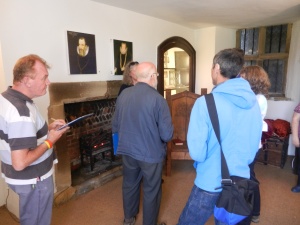Visit to the Manor Lodge, Sheffield
Located in the middle of a housing estate in Sheffield, Manor Lodge was an interesting archaeological jigsaw for the group to investigate. Originally a medieval hunting lodge it had been rebuilt in Tudor times. The group began by recording the exterior of the Turret Tower, including the doorways and windows, and the different stonework. They were very surprised to discover an old stone coffin outside. The group expected it to be bigger inside the Tower, perhaps with more rooms, which led to an interesting debate about the thickness of the walls. The room that evoked the most discussion was the banqueting room, which was decorated with an intricate ceiling featuring images of Talbot dogs.

The group with Gordon our volunteer who has been helping at all sessions since the start of the course.
Outside, the group examined the archaeological remains and interpreted what they could tell us about the history and evolution of the site. They observed the different structures built against the wall of the Long Gallery and found out that they were the remains of cottages and workshops built for the industrial workers who inhabited the site in the 18th and 19th centuries. They also located the site of the old pottery kiln, which they had studied in a previous session about industrial archaeology. The chimneys and fireplaces were another focus for group discussion, as well as the differences in the stonework.
By the end of the session the group collectively agreed that they had learned so much about the site, and had found it invaluable to have the opportunity to ask questions. Some of the group explained how in the past they had visited sites on their own and never been able to ask questions, but that being part of this course with an interpreter they were able to ask questions and engage in group debate.
Our first week was an introduction to archaeology, with the opportunity to share ideas and experiences – and ask lots of questions. The group discussed how the design and manufacture of different objects had changed over time. They also constructed a timeline of Sheffield heritage. The second week built upon this chronological foundation as the group explored archaeology in museums and archaeological finds. As the course is based at Weston Park Museum in Sheffield, we had an introduction to archaeology in museums by the curator of archaeology, Helen Harman. We discovered some of the roles and responsibilities of the archaeology curator, and the challenges museums face, before exploring the archaeological collection in the museum. The group were particularly interested in the rare Anglo Saxon helmet and accompanying finds. They also had the opportunity to give feedback on what they thought about the display of the archaeology collection, and had lots of innovative ideas from the perspective of deaf people. Later in the session the group had the opportunity to handle archaeological artefacts, most of which were Roman pottery found in the Doncaster area. They enjoyed recording them and debating what their fragment was once part of – it gave them an insight into the challenges archaeologists face when they only find small fragments of objects.





